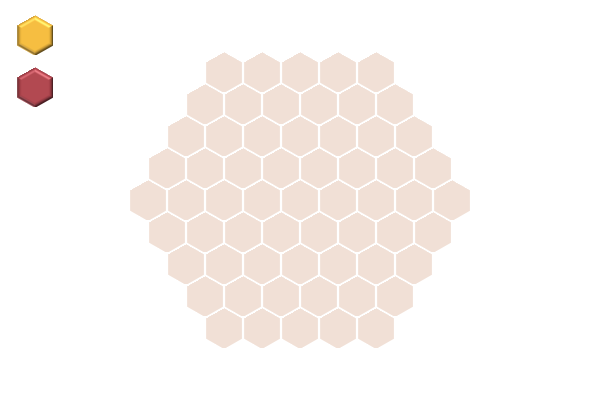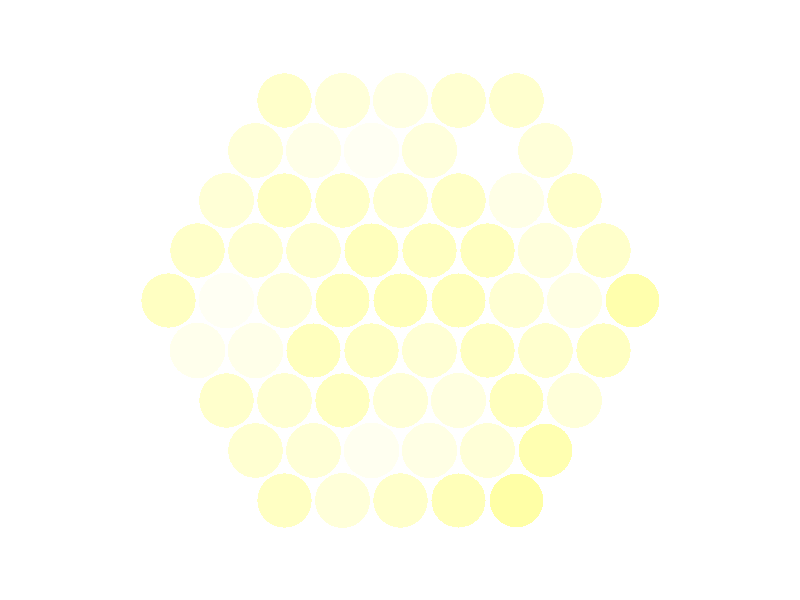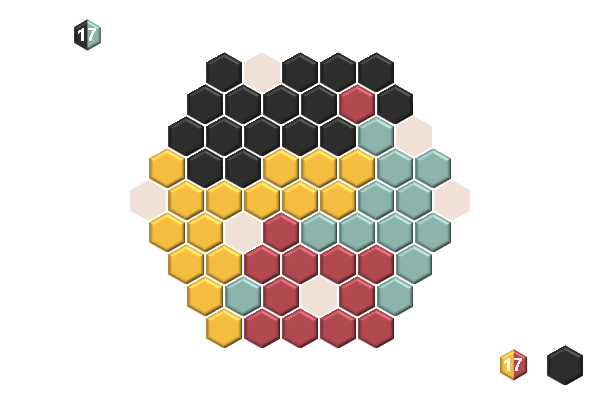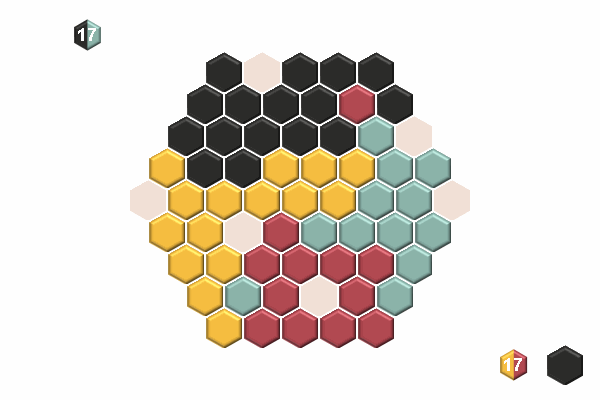| User | Rating | Comment |
|---|
| Thunkd | 6 | Blooms is a game inspired by Go. It's played on an hexagonal board and each player controls two colors. One player starts and plays a single tile. After the initial placement, players may play up to two tiles, but of different colors. A bloom is a connected segment of one color. If all the surrounding tiles of a bloom are filled by an opponent, it is captured. One twist here is that one of your colors can contribute to capturing another of your colors. There's a rule that none of your pieces can be in a space that would self-capture but it's only enforced at the end of the turn after you capture opponent's blooms. The game is head-twisty for Go players and things are similar but fundamentally different. |
| kalendrys | 4 | |
| ChrisSmith4773 | 8 | |
| mrraow | 10 | I have heard playing go compared to playing four games of chess simultaneously on the same board; playing Blooms is undoubtedly like playing two games of go simultaneously... on a very small board. An interesting game with a lot of depth - and a real pig to programme! |
| gaming_fool | 7 | |
| bluesheep | 7 | |
| Sirumi | 6 | |
| mattcurtis89 | 8 | |
| mirror33 | 7 | This isn’t immediately fun like Catchup was, but I can see it having real legs. Update! (like a week later)...or, why play this instead of small board Go? |
| cryptosha | 7.5 | |
| attackofmilk | 10 | [2p, abstract] ==2018/12/31== It's spatially differently than Chess. A lot of the abstracts I've played scratch the Chess part of my brain; single pieces are threats, and you have to consider how to place pieces to defend against those threats. Blooms (like Go, probably) is about surrounding things. The rhythm of sacrifice/sacrifice in Chess is replaced by capture/capture-back. The capture/capture dance is interesting because you're trying to figure out how to trick your opponent into filling up the empty space around their bloom with their own pieces, but without letting them create defensive eyes. The two-moves-per-turn also makes the game harder to foresee and anticipate. Also, the new prisoner scoring system simplifies the game a lot. I tried explaining the game tonight using the new ruleset, and I was concerned that I was forgetting something because the rules explanation was so short. This game seems truly easy to teach, though the game still has a lot of depth. While it's technically in the same genre as Chess (in terms of perfect information and the nonrandom mechanics), it feels totally different to play. The novelty and strangeness of it is part of why I love it; I wonder if my enthusiasm for the game will wane with familiarity. Currently a 10. ==2018/09/30== It's good. BUT, it shares Exceed's problem where I'm a lot better than the new people I teach it to. Needs a dedicated partner. |
| Craftsman | 6.6 | |
| JasonSaastad | 6 | |
| yaron | 7 | |
| LukeJS | 7 | |
| Tolkana | 8 | |
| mxmth | 5 | |
| duggo42 | 5 | |
| schwarzspecht | 8 | |
| KrysKrys | 5 | |
| Sqrt2 | N/A | DIY (board of size 4). |
| Wentu | 7 | I rate it just 7 now because I played it not enough but it could surely be a 7.5 or 8 I love that it recalls (strongly) Go but it is very original at the same time, in that it uses 2 colors per player in a nice fashion. You surely must try it if you love abstract games. Fast, easy, clean and original as all good abstracts should be. |
| robkoch2112 | 9 | |
| stevejuggler | 1 | |
| The Player of Games | 9.25 | Very interesting, unique and beautiful game! Feels somewhat like multicolored Go on a hexhex board. Need to explore more. Preliminary rating based upon play on a hexhex4 "beginners" board. Need to try with a hexhex5 board. Expect rating to increase. Update: Playing Blooms on a hexhex5 is more satisfying. Increased rating from 8 to 8.5. May still increase further. Wonder how the hexhex6 game feels. Further update: Even better when played on a hexhex6. More strategic. Increased to a 9. This is a great game. However, will probably prefer to play the hexhex5 against less experienced opponents as the hexhex6 game is longer and favor skilled board gamers due to the more pronounced strategic level of play due to the larger board. Further update: Rating raised to 9.25 to reflect position in my top 10. Blooms is currently my preferred abstract after [thing=188] [/thing], [thing=194655] [/thing], and [thing=2065] [/thing]. Further update: New Rules! (Nov 2018). Simplified rules, that prevent (very rare!!!) cycles. The player that first captures X (number to be decided by the players) stones from the opponent wins. Interesting combination of 1) scoring captured stones only, 2) allowing suicide, and 3) banning of passing. If the number of captured stones X is chosen high enough (1/3-1/2 of the total number of hexes in the board) this leads to essentially same gameplay as when using Go-like area scoring. A low X would change the flow of the game. I see X as a feature allowing the players to tweak the game as an alternative to (or in addition to) using time limits. New rules requires a scoring track next to the board or enough stones to pile up the captured stones (which then are not returned to the opponent). After some plays using the new rules, I have decided not to change my rating of the game. Same game with simpler rules and more features. Pnp boards on vinyl and 1.75'' Backgammon pieces (50 each in brown, butterscotch, red, white, salmon, teal + 95 blue). |
| bdeink | 7.5 | I think Blooms might be the best new abstract I've played. Should play more. |
| Sintonic | 5 | + it's ok abstract - I find it a little boring played only at BGA |
| grasa_total | 7 | (7 plays.) Being bad at Go has always just made me despair. Being bad at Blooms, on the other hand, makes me want to play a lot more and get better. (Will I? I don't know.) Maybe it's because it's small, and so the path I'd be starting down isn't as long as with larger, classic games. But it also doesn't have the nice learning curve of Catchup, where every dumb mistake teaches me something. So far my dumb mistakes at Blooms only feel like the slightest glimmer of enlightenment. |
| ceenan | 8 | |
| lasttruegypsy | 6.339 | |
| HQ063 | 5 | |
| lulu35 | N/A | BGA 2j |
| SpelerJ | 5 | |
| Kunkasaurus | 8 | Colorful Go |
| valy24 | 8 | |
| epicgamer | 8 | Only played online so far, but really like it. Reminds me of Hex and Go a little bit. Would buy it retail if a neat version comes out. |
| RobertBr | 6 | Being a two-player abstract always marks a game down - after all its ill suited to most board gaming situations, which usually require more than two players in a game and the no luck puts a lot of people off. On the upside this one is quite pretty and features some novel and interesting features resulting from each player controlling two independent but mutually supporting colours. On the downside is a rather dull endgame. |
| KingsElite | 3 | |
| Tr0llet | 7.5 | |
| Metttyu | 7 | PNP; very interesting fast 2-player Go-like abstract on a hex board where each player controls two colors. |
| Reuner | 7 | |
| _The_Inquiry_ | 7 | Prior to 2020: 2 plays |
| Plush | 5 | |
| zzzabiss | 5 | |
| ponchera69 | 6 | |
| Gizensha | 7 | |
| big_buddha | 9 | |
| ChristianDK | 8 | |
| mirth00 | 6.3 | |
| matztias | 10 | |
| Friendless | 9 | Feels like Go, but is much more accessible. Very nice. |
| bootleby | 7 | |
| carontissimo | 7 | |
| BoltKey | 7 | A very fun and elegant game. The rules are dead simple and elegant. Complete information games are not exactly my thing though. Probably not going to play it too much. |
| i_am_ignis | 8 | |
| Kolo_z_Wrocka | 10 | |
| dooz | 7 | |
| dmlyrae | 7 | |
| kevan | 7 | Haven't got my teeth into it that deeply yet, but seems like an elegant and simple one. First time in a while I've been inspired to make a hex board. |
| Messier | 4 | |
| luigi87 | 9 | Fixes the tactical bluntness of hexhex Go by adding a second piece color to each player and a second placement per turn, and addresses the ensuing cycles with a capture cutoff that doubles as the only winning condition and replicates territory scoring (minus a group tax) thanks to the absence of illegal placements. Brilliant. |
| s_jared | 8 | |
| aclif | 7 | Interest game. Not my favorite from Nick Bentley |
| rayzg | 5 | Very clever adaptation of Go on a hex board, but it still feels like Go, and I don't particularly enjoy that game. |
| kikil | 8 | |
| Themer | 7 | |
| orangeblood | 9 | I’m quite optimistic Blooms is going to turn out to be a great game. It brings in some fun elements from Go along with the necessity to control two colors in a way so you keep pressure on your opponent while trying not to harm yourself. It's a fine line, making gameplay thrillingly tense. It feels familiar yet brand new at the same time. Everything about it feels right so far. Update: Time to raise the rating another point. I’ve logged 22 games with the 2.0 rules and am having a blast simply playing AiAi. No telling how the rules will eventually settle, but it’s a great game already. At this point I’m using x values of 18 for size 4 and 20 for size 5. AiAi isn't very strong at larger sizes so I don't have an opinion for the size 6 value. |
| pete100 | 6 | |
| hojoh | N/A | D |
| drillmaster | 7.5 | |
| _wolo_ | 7 | |
| RicardoRix | 10 | Very simple rules, tense battles. |
| Formersd | 5 | |
| rayr | 8 | = 2018-08-30 It seems premature to comment on this game given that I've only played it three times and I barely know what I'm talking about, but that never stopped me with Euros so here goes. Abstract game designers make a big deal about precise and minimal rules. I once participated in a thread that spent four pages trying to rephrase the 2nd rule of a game so they could avoid adding a 3rd rule. Where a family game will spell out for you the path to progress in the game, an abstract game will tell you the exact way in which components are allowed to be placed on the board and everything else emerges from that. It's like learning to build a doghouse by reading the instructions for a hammer and saw. "A minute to learn and a lifetime to master" is really code for "A minute to have someone gloat about the minimal ruleset and a lifetime of being too intimidated to try it". That was the story of me and Go. Not counting the methods for scoring and the special cases for a few degenerate cases, Go has a fantastically minimal set of rules and yet you could play it hundreds of times and still not be considered good at the game. Even worse, if you don't have a book or experienced player to guide you, the game can seem pointless; you'll have no idea what you should do or how to evaluate the quality of your play. Frustration for me is failing at something and not knowing how to do better next time. Enter Blooms. With some finely crafted animated gifs to show you roughly how the game could progress, the author has given you the confidence that things are happening as they should. With a 61 hex board (5 hexes on each side), you can get to the meat of the game quickly. With a shorter number of moves between action and consequence, you can point back to your mistakes and learn from them. Most importantly, the game is fun to play even when you don't yet know what you're doing. Fans of abstracts tend to restrict themselves to comparing these games only to other abstracts and so you'll mostly see Blooms compared to Go, but that's only so we can use terms like 'liberties' and 'eyes'. It's also an area control game. You're defending your supply lines and trying to surround the enemy. There are no cards or special powers, there are no costs to build or resources to exploit, but there are emergent interactions which suggest higher order strategies and identical components will play very different roles. One of the most insidious rules in Blooms is you can't end your turn with any of your own blooms fenced (having no liberties, in Go terms). In my last play, there was a move I so badly wanted to make with one of my colors, but doing so would fence in my other color. My opponent knew this and refused to kill off that piece for me. His entire battalion was safe because of that one prisoner of war. Blooms makes me want to set fire to my collection and finally spend a lifetime mastering a game. If you remember a time when you rejected boardgames because you didn't like Scrabble, Risk and Monopoly but then you found Catan, Azul or Gloomhaven; if you've been avoiding abstracts because you don't like Chess or are intimidated by Go; if you want to be surprised by how much you're going to like a family of games you'd previously written off, you owe it to yourself to give Blooms a shot. NOTE: If you'd like a more gentle introduction to modern abstracts, I highly recommend trying Yavalath and then Pentalath. Remember that Abalone or Chinese Checkers board your friends gave you because they heard you liked games? That's perfect. Go dust it off. Here are the rules to Yavalath: * Each player picks a color and then takes turns playing one stone/marble onto any open space. * You win if you can get four in a row. * You lose if you get three in a row. Don't think about it too much. This is one of those games where the "Ah ha!" hits you really fast. Play that a few times and then try Pentalath. Now you're ready for Blooms. |
| getareaction | 7 | Only played online. |
| astrowhiz | 9 | |
| Vanatox | 5 | |
| Thesse1955 | 6 | |
| russ | 6 | Go variant (2 colors per player, hexes) which I feel like I should like more than I do, but I feel like I'd simply rather play real Go. I'm also not a fan of the rule change that counts captured stones until you reach a winning threshold number of captures, which was added after Anna and I stumbled upon an (apparently very rare) non-terminating cycle. [url=https://www.boardgamegeek.com/blogpost/89236/monthly-tournament-results-april-combinatorial-gam]I wrote an extensive blog post about this and 9 other combinatorial games from 2018[/url]. |
| paynentt | 7 | |
| sophie_ita | 7 | A solid abstract. Easy to play hard to master. |
| Ranior | 7 | A clever game inspired by the idea "how would you play Go on a hex board?". I enjoyed my play of this and would like to play more. It has that annoyingly good feature that I continue to think about the game long after I was done playing it, considering how to do better the next time and the lessons I learned from that play. I could see this rating increasing with more plays, but now it's up to fate and my interest to see if it gets more plays and is able to hook me. |
| mschlat | 8 | It's like a mini-game of Go. Extremely simple ruleset and very nice thinky play. |
| milomilo122 | 10 | Provisional rating. I'm the designer. Of the many games I've designed in two decades of designing combinatorial games, this is the first I rate a 10. I've played Blooms around ~100 times now, and it's my favorite of my games. That won't likely change unless I find something wrong with it. But the game is young, so I'm looking for signs of trouble. If I find any, I'll downgrade. If I don't, I doubt I'm capable of making a game I like better. Further reading: * [url=https://nickbentley.games/2018/03/14/blooms-rules/]Rules (and brief commentary)[/url] * [url=https://nickbentley.games/2018/05/31/life-in-blooms/]Article comparing Blooms to Go (its closest relative)[/url] |
| tkvaran | 9.5 | |
| ProZD | 7 | |
| Kaffedrake | 5 | The similarity to Go may be overstated: at least on small and smallish boards (4-5) it definitely feels more like a game of tempo than one of influence. It's certainly possible larger boards offer more in terms of strategic scope, but Ai Ai can barely play strategically on a 5-board. I wish the win condition wasn't based on captures, and at the very least, official levels are required. |
| Iguanoman | 7 | |
| Robrun | 7 | |
| holf | 6 | 一位玩家控制兩種顏色的圍棋,等於是兩種思考 |
| fjaoaoaoao | 6 | |
| bluebee2 | N/A | Pnp |
| jefferydoc | 8 | |
| slimy_asparagus | 7 | Print and play. If a single sheet of paper counts as a copy, then I own a copy. We are using trilemma and go pieces. |
| wxdaxmh1314 | 8 | |
| pezpimp | 5 | Based on one play: Very similar to Go except that you control two colors and it plays on a hex board. You must play your pieces to surround your opponents sets to capture them. Can't say I am a fan of Go so this will likely only appeal to those looking for a similar, if slightly simpler game. |
| heggahegga | N/A | 2 Player |









